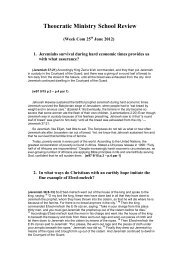1964 Awake! - Theocratic Collector.com
1964 Awake! - Theocratic Collector.com
1964 Awake! - Theocratic Collector.com
You also want an ePaper? Increase the reach of your titles
YUMPU automatically turns print PDFs into web optimized ePapers that Google loves.
If the snow continues on the mountain<br />
over a long period, these sturdy plants will<br />
remain dormant, awaiting the spring. With<br />
its <strong>com</strong>ing, the awakened plant will concentrate<br />
all its stored energy on growth.<br />
They are definitely not quick starters<br />
ready for a sprint, but slow and frugal<br />
growers.<br />
One of these slow-growing plants that<br />
meets the challenge of the mountains is<br />
the cushion plant. It will sprout two leaves<br />
yearly and not develop its first flower before<br />
the tenth year. In these ten years the<br />
plant will grow but one-third of an inch.<br />
At the end of twenty years, it will be only<br />
about one foot in diameter, but will be covered<br />
with hundreds of tiny pink flowers.<br />
Shaped like a boulder, the cushion plant,<br />
moreover, hugs the rock crevices below<br />
the heat-sapping force of the winds that<br />
may whirl around the valleys at a hundred<br />
miles an hour. Its shape and the multitude<br />
of tiny flowers covering it during the summer<br />
make it an excellent heat trap, a heated<br />
apartment house where insects that<br />
would otherwise be blown away with the<br />
wind can take refuge.<br />
Many of the other alpine plants that are<br />
similarly designed for the climate are miniature<br />
specimens of their lowland relatives.<br />
These plants also meet the challenge of<br />
mountain life by being especially equipped<br />
with heat-retaining devices. The snow willow,<br />
for example, has a bud very similar<br />
to that of the pussy-willow tree and is<br />
black, thus highly heat absorbent. In turn,<br />
this black core is covered with a white<br />
mass of fuzz that reflects back any heat<br />
that would otherwise be lost, trapping it<br />
and storing it for future use. Yet another<br />
aid to heat absorption is provided by the<br />
leaves of many plants, nearly all of them<br />
being dark green in color. Still others have<br />
a thick waxy coating that prevents excessive<br />
evaporation.<br />
MAROH 8, <strong>1964</strong><br />
Animals Meet the Challenge<br />
Challenging, though the alpine conditions<br />
may be to the plant'life that inhabits<br />
the mountains, plants are more or less<br />
stable; and they can find protection in rock<br />
crevices or under the canopy of an overhang.<br />
Their long taproots, often three<br />
feet to the plant's ten to twelve inches of<br />
surface height, anchor them against wind<br />
and rain and the continual gravitational<br />
pull that would otherwise drag them down<br />
the slopes. But animals are usually on the<br />
move. The fierce winds and bitter cold,<br />
with the constant need for food, would<br />
soon sap these mountain dwellers of all<br />
their strength were it not for the foresight<br />
of their Creator in designing them<br />
especially for their environment.<br />
What a masterful knowledge of design<br />
was demonstrated in the creation of the<br />
varying hare or snowshoe rabbit! This<br />
creature escapes from enemies by speedy<br />
flight. But when an animal is fleeing, its<br />
body mechanism is working at maximum<br />
capacity. Heat is produced at a tremendous<br />
rate. This heat must be dispelled. The<br />
larger the surface area of a given body<br />
the more quickly can heat be lost through<br />
evaporation. So when in flight this rabbit<br />
is a long lean shape stretched out for<br />
action.<br />
But the mountain snowshoe lives in a<br />
frigid climate. A streamlined body is hardly<br />
what is called for when it <strong>com</strong>es to <strong>com</strong>bating<br />
the cold. Ah! but take another look<br />
now that this animal is at rest. See how<br />
he has curled himself up! And the colder<br />
it gets, the tighter he curls. Unlike his lowland<br />
cousins, his little ears are short and<br />
fuzzy. He lays them out flat along his back.<br />
Now he looks just like a ball. His belly,<br />
where the hair is finer and shorter, has<br />
<strong>com</strong>pletely disappeared inside the ball and<br />
Mr. Snowshoe is ready to sit out the coldest<br />
spell.<br />
25




